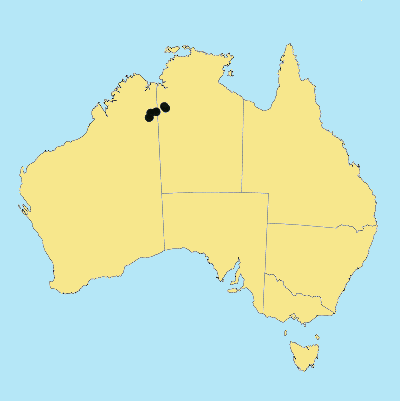Triodia roscida N. T.
Burbidge. Austral.
J. Bot. 1: 176
(1953).
Classification. (GPWG 2001) : Subfamily
Chloridoideae. Triodeae.
Type of Basionym or
Protologue Information: Australia: Western Australia: 1 mi SE of Turner
Station, Kimberley district, 9 Jul 1949, R.A. Perry 2404 (HT: CANB; IT:
AD, BRI, CANB, K, MEL, NSW, NT, PERTH, US).
Key references
(books and floras): [2002] D.Sharp & B.K.Simon, AusGrass, Grasses of
Australia.
Habit.
Perennial. Stolons present. Culms 60–300 cm tall. Mid-culm internodes glabrous.
Mid-culm nodes glabrous. Leaf-sheaths hairy. Leaf-sheath auricles absent.
Ligule a fringe of hairs. Leaf-blades aciculate, conduplicate, 15 cm long.
Inflorescence.
Inflorescence compound, a panicle of racemes. Racemes appressed, linear, 4–7 cm
long. Central inflorescence axis 15–25 cm long.
Spikelets.
Spikelets pedicelled. Fertile spikelets many flowered, with at least 2 fertile
florets (3–4), comprising 3–4 fertile floret(s), with diminished florets at the
apex, oblong or cuneate, laterally compressed or terete, 6–10 mm long.
Glumes.
Glumes similar, thinner than fertile lemma. Lower glume lanceolate or oblong,
scarious or coriaceous or indurate, without keels, 3–10 -nerved. Lower glume
surface glabrous. Lower glume apex mucronate. Upper glume lanceolate or oblong,
4.5–7 mm long, scarious or coriaceous or indurate, without keels, 3–10 -nerved.
Upper glume surface glabrous. Upper glume apex entire, mucronate.
Florets.
Fertile lemma 6–8 mm long, without keel or keeled, 9–12 -nerved. Lemma surface
indumented. Lemma apex lobed, muticous. Anthers 3.
Continental
Distribution: Australasia.
Australian
Distribution: Western Australia, Northern Territory.
Western Australia:
Hall. Northern Territory: Victoria River.
Notes.
Distinguished by its spiciform racemose panicle; closely few-flowered
spikelets; subequal, mucronate, many-nerved glumes from c. 1/2 to almost as
long as spikelet; deeply lobed many-nerved lemmas; bifid palea long relative to
its lemma; often long-hairy leaves and presence of droplets of a brown
secretion; glaucous foliage.
Kimberley
Region and Hall District, W.A., and adjacent parts of the N.T. Volcanic and
limestone outcrops; stony alluvial creek banks; cherty gravels, brown clays and
calcareous soils; rocky skeletal hillslopes; gravelly laterite-capped mesas;
flowers Feb., Apr.-Aug.




